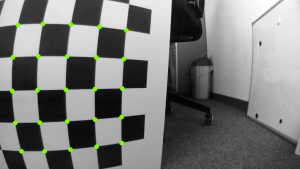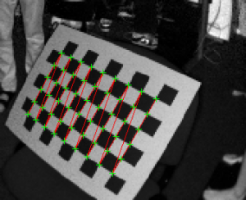
Friedrich-Alexander-Universität Erlangen
Lehrstuhl für Mustererkennung
Martensstraße 3
91058 Erlangen

Many camera calibration techniques require the detection of a pattern with known geometry, e.g., a checkerboard. Typically, the pattern must be fully contained in the field of view. This brings several limitations, one of which is that lens distortion can not reliably be estimated in outer image regions.
This paper presents the occluded checkerboard pattern detector (OCPAD) to find checkerboards, even in a) low resolution images, b) images with high lens distortion and if c) the pattern is partly occluded or not completely within the field of view. We exploit that checkerboards can easily be represented by a graph. We use graph matching to find the largest partial checkerboard in the image. Our detector complements a state-of-the-art calibration algorithm. Quantitatively, detection rates are considerably improved over the state-of-the-art. Additionally, estimation of lens distortion is greatly improved at outer image regions. Here, the reprojection error is improved by up to 50%.

This paper presents a new checkerboard detection algorithm which is able to detect checkerboards at extreme poses, or checkerboards which are highly distorted due to lens distortion even on low-resolution images. On the detected pattern we apply a surface fitting based subpixel re- finement specifically tailored for checkerboard X-junctions. Finally, we investigate how the accuracy of a checkerboard detector affects the overall calibration result in multi-camera setups. The proposed method is evaluated on real images captured with different camera models to show its wide applicability. Quantitative comparisons to OpenCV’s checkerboard detector show that the proposed method detects up to 80% more checkerboards and detects corner points more accurately, even under strong perspective distortion as often present in wide baseline stereo setups.



This paper presents a new checkerboard detection algorithm which is able to detect checkerboards at extreme poses, or checkerboards which are highly distorted due to lens distortion even on low-resolution images. On the detected pattern we apply a surface fitting based subpixel re- finement specifically tailored for checkerboard X-junctions. Finally, we investigate how the accuracy of a checkerboard detector affects the overall calibration result in multi-camera setups. The proposed method is evaluated on real images captured with different camera models to show its wide applicability. Quantitative comparisons to OpenCV’s checkerboard detector show that the proposed method detects up to 80% more checkerboards and detects corner points more accurately, even under strong perspective distortion as often present in wide baseline stereo setups.
Many camera calibration techniques require the detection of a pattern with known geometry, e.g., a checkerboard. Typically, the pattern must be fully contained in the field of view. This brings several limitations, one of which is that lens distortion can not reliably be estimated in outer image regions.
This paper presents the occluded checkerboard pattern detector (OCPAD) to find checkerboards, even in a) low resolution images, b) images with high lens distortion and if c) the pattern is partly occluded or not completely within the field of view. We exploit that checkerboards can easily be represented by a graph. We use graph matching to find the largest partial checkerboard in the image. Our detector complements a state-of-the-art calibration algorithm. Quantitatively, detection rates are considerably improved over the state-of-the-art. Additionally, estimation of lens distortion is greatly improved at outer image regions. Here, the reprojection error is improved by up to 50%.